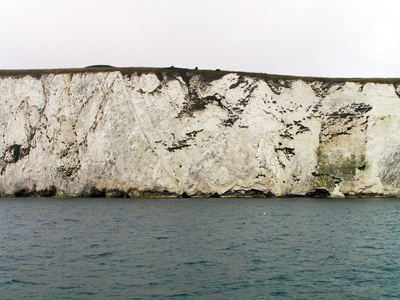
The Jurassic Scene tied up at Poole Quay - it takes trippers over to Swanage around the Jurassic Coast
In August 2010, on a drizzly day, we took a boat trip from Poole Quay to Swanage, around Old Harry Rocks on the Jurassic Coast of East Dorset.
We had already seen these chalk stacks in the distance from various points – from Brownsea Island, from Studland and even from Bournemouth. So they were a sight we wanted to view from a closer vantage point.

Old Harry Rocks can be seen from Brownsea Island, looking through the mouth of Poole Harbour, from Studland and even from Bournemouth

Old Harry Rocks can be seen from all over East Dorset - this is a view from Brownsea Island, snapped in 2009

A Harry Paye day is held every June on Poole Quay to celebrate the notorious pirate, who died in 1419...
Some say the Old Harry of the name is the devil, others believe it was named after the famous Poole pirate Harry Paye, who died in 1419.
Old Harry Rocks mark the eastern end of the Jurassic Coast UNESCO World Heritage Site. The cliffs have gradually eroded over the centuries, with new isolated stacks forming as the arches grow and breach into gaps. The small stump next to Old Harry himself (the end stack) used to be of equal stature and is known as Harry’s wife, but she crumbled in 1896.
The western end of the Jurassic Coast is at Orcombe Point near Exmouth in East Devon and from there to Old Harry the distance is 95 miles (153 kilometres).

Vehicles at Studland awaiting the arrival of the chain ferry across the mouth of Poole Harbour to Sandbanks
The cliffs are made of limestone, with thin bands of flint. Some geologists believe they were originally joined up to the Needles, similar stacks off the Isle of Wight, and formed a range of hills until they were inundated at the end of the last Ice Age about 14,000 years ago.
Until the 1770s it was possible to walk all the way along from the headland of Handfast Point to Old Harry, before the rocks crumbled and the gaps formed.

Old Harry Rocks from the Swanage side – the stretch in the middle is known as No Man’s Land and the gap between it and the headland of Handfast Point is called St Lucas' Leap

Old Harry Rocks - the tiny stump next to Old Harry himself used to be his wife, but the rock crumbled into the sea in 1896
Although it’s called the Jurassic Coast, it consists of Triassic, Jurassic and Cretaceous cliffs, spanning the Mesozoic Era, documenting 180 million years of geological history.
The stretch of chalk between Old Harry and Swanage, around Ballard Point, formed towards the very end of the Cretaceous period, over 65 million years ago.
Chalk is almost pure limestone (calcium carbonate), made from trillions of microscopic skeletons and shells from plankton which fell to the seabed in the warm waters of the time and formed characteristic horizontal strata or layers.
The chalk also contains fossils of larger creatures such as ammonites, gastropods, sea urchins, sponges and bivalve sea shells.
Sponges and a type of plankton called radiolaria used silica instead of calcium carbonate to form their skeletons and when they died their remains formed nodules of hard, black flint, a glassy material which appears in bands as a distinctive feature of the chalk cliffs.
At the end of Ballard’s Point the strata have been tilted by upheavals to become vertical.

The Jurassic Coast between Old Harry Rocks and Ballard Point - look at those diagonal strata of the Ballard Fault...

Cargo vessels in Poole Docks - many leave with gravel or china clay from the stone of the Isle of Purbeck, the peninsula to the south of Poole
Some useful links:
The Jurassic Coast official website
The Jurassic Coast on Wikipedia
The geology of Old Harry and Ballard Point in detail
The website for Blue Line Cruises around Old Harry Rocks


























Hello again.I have just taken another look at your blog and absolutely love the page about Old Harry Rocks.Have been to Dorset many times but did not know about them. Would love to come searching for fossils. Alas,I now live in Crete.
Yes, the Jurassic coast is wonderful. I just came across this quite good picture of Studland with Old Harry Rocks right in the distance, on the Telegraph website.
I also love Crete, although I haven’t been there for decades. Mostly I remember Iraklion, Knossos, Phaestos and Matala – the last being where Joni MItchell wrote Carey…
Have a good day, as they say…
🙂
Thanks for the Link to your stone diary memories Pat. We are not far from Iraklion,a place called Agios Nikolaos Crete.
Great post, nice sequence.
Thank you – I like your pix of Old Harry Rocks, too. For those interested, they are here.
Best wishes 🙂
Hi!
I would like to enquire into the possibility of using one of your beautiful images of Old Harry Rocks in an academic book I am editing.
I would be so grateful if you could be of any assistance!
Kind regards,
Amy
No problem – I have emailed you for more info.
Best wishes 🙂